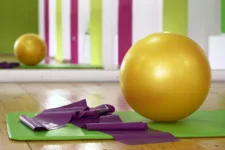When you have a baby your daily routine changes drastically. You have to adjust your sleeping and eating patterns and you have less time for yourself. This may mean your exercise routine loses its priority. The problem with sacrificing staying in shape is you may have less energy and endurance to get through the challenges of your baby’s first months and years.
Wouldn’t it be better to stay active after your baby comes along? Not only will you be healthier and less stressed, you will be passing on great habits to your child. If you make the commitment to your health, there are ways of staying active when you have a baby.
During pregnancy
Being healthy when you have a child should start before you give birth. Bed rest before birth is no longer the norm, as women now reap the benefits of exercising most days of the week during pregnancy. Walking is a fantastic way to keep active during pregnancy, and the efforts you put in will help you bounce back faster after giving birth.
Exercise with a newborn
With their doctor’s approval, new moms can start exercising soon after the baby is born, and in fact, moving a bit every day is wise. But because newborns don’t sleep through the night, many new parents end up sleeping when their baby sleeps. This can leave you sleep deprived and less motivated for exercise. So instead of using nap time to work out, you can include your baby in your workout.
Walking with your baby is one of the best and easiest ways to exercise right after birth. You can start with small distances, and build up your endurance and strength with your baby safely sleeping in a carriage. Once you are stronger, you can increase your endurance by carrying your baby. Bear in mind no matter what kind of shape you were in before you were pregnant and gave birth, your body will have changed, and it will need time to rebound. Start slow, and be patient with yourself.
If you want to focus on flexibility and strength, you can incorporate stretches like a cobra back stretch and a hamstring stretch with your baby on the floor near you. You can do strength training by substituting your baby for weights. You can do arm lifts, put your baby on your stomach and sit-up to him, and hold her in a carrier while doing squats. Some gyms offer classes that integrate you and baby with stretches, dances and songs.
Working out with older babies
As your baby gets older, one way to keep your exercise routine intact is to invest in toys that engage your child while you spend time working out. For example, stationary baby activity centers will entertain your baby while you dance to your favorite DVD, and a baby activity center will keep your baby safe as it spurs developmental growth. There are also some great apps you can download to your mobile device. Look for a High Intensity Interval Training (HIIT) app, which lets you do short spurts of intense exercise for as little as four minutes.
You can start to teach your baby her own workout routines at a very young age. Many communities and gyms now offer swimming and workout classes for parents and children together. If these classes aren’t available, you can simply teach your child to kick, blow bubbles, hold his/her breath and eventually swim. Young children can start going with you on biking trips, first in a carrier, but later on their own tricycles and bicycles. Taking hikes with your baby in a pack, and later in his or her own hiking boots will instill in both of you an appreciation of nature and healthy living.
One important way to ensure you establish an exercise routine is by enlisting some help. Check out the nearest postpartum exercise group. Ask friends and family to watch your baby or accompany you on your walks. Keep an exercise diary that you share with at least one other person who will motivate you to keep at it.
Your commitment to exercise depends on taking advantage of new opportunities and support from those around you. Whether you are trying to lose baby weight, or simply have the energy to play with your baby, you will never regret your quest for better health. As your baby grows, he or she will also learn to value the benefits of being fit.








